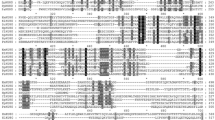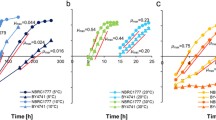Abstract
The yeast, Candida guilliermondii, has been widely studied due to its biotechnological interest as well as its biological control potential. It integrates foreign DNA predominantly via ectopic events, likely through the well-known non-homologous end-joining (NHEJ) pathway involving the Ku70p/Ku80p heterodimer, Lig4p, Nej1p and Lif1p. This phenomenon remains highly deleterious for targeted gene knock-out strategies that require the homologous recombination process. Here, we have constructed a ku70 mutant strain derived from the ATCC 6260 reference strain of C. guilliermondii. Following a series of disruption attempts of various genes (FCY1, ADE2 and TRP5), using several previously described dominant selectable markers (URA5, SAT-1 and HPH #), we demonstrated that the efficiencies of homologous gene targeting in such a NHEJ-deficient strain was very high compared to the wild type strain. The C. guilliermondii ku70 deficient mutant thus represents a powerful recipient strain to knock-out genes efficiently in this yeast.




Similar content being viewed by others
References
Abbas CA, Sibirny AA (2011) Genetic control of biosynthesis and transport of riboflavin and flavin nucleotides and construction of robust biotechnological producers. Microbiol Mol Biol Rev 75:321–360
Abdel-Banat BM, Nonklang S, Hoshida H, Akada R (2010) Random and targeted gene integrations through the control of non-homologous end joining in the yeast Kluyveromyces marxianus. Yeast 27:29–39
Aravind L, Koonin EV (2001) Prokaryotic homologs of the eukaryotic DNA-end-binding protein Ku, novel domains in the Ku protein and prediction of a prokaryotic double-strand break repair system. Genome Res 11:1365–1374
Boretsky Y, Voronovsky A, Liuta-Tehlivets O, Hasslacher M, Kohlwein SD, Shavlovsky GM (1999) Identification of an ARS element and development of a high efficiency transformation system for Pichia guilliermondii. Curr Genet 36:215–221
Boretsky YR, Pynyaha YV, Boretsky VY, Kutsyaba VI, Protchenko OV, Philpott CC, Sibirny AA (2007) Development of a transformation system for gene knock-out in the flavinogenic yeast Pichia guilliermondii. J Microbiol Methods 70:13–19
Boretsky YR, Pynyaha YV, Boretsky VY, Fedorovych DV, Fayura LR, Protchenko O, Philpott CC, Sibirny AA (2011) Identification of the genes affecting the regulation of riboflavin synthesis in the flavinogenic yeast Pichia guilliermondii using insertion mutagenesis. FEMS Yeast Res 11:307–314
Butler G, Rasmussen MD, Lin MF, Santos MA, Sakthikumar S et al (2009) Evolution of pathogenicity and sexual reproduction in eight Candida genomes. Nature 459:657–662
Courdavault V, Millerioux Y, Clastre M, Simkin AJ, Crèche J, Giglioli-Guivarc’h N, Papon N (2011) Fluorescent proteins fusion in Candida guilliermondii. Fungal Genet Biol 48:1004–1011
Fitzpatrick DA, Logue ME, Stajich JE, Butler G (2006) A fungal phylogeny based on 42 complete genomes derived from supertree and combined gene analysis. BMC Evol Biol 6:99
Foureau E, Clastre M, Millerioux Y, Simkin AJ, Cornet L, Dutilleul C, Besseau S, Marais E, Melin C, Guillard J, Crèche J, Giglioli-Guivarc’h N, Courdavault V, Papon N (2012a) A TRP5/5-fluoroanthranilic acid counter-selection system for gene disruption in Candida guilliermondii. Curr Genet 58:245–254
Foureau E, Courdavault V, Simkin AJ, Pichon O, Crèche J, Giglioli-Guivarc’h N, Clastre M, Papon N (2012b) Optimization of the URA-blaster disruption system in Candida guilliermondii: efficient gene targeting using the URA3 marker. J Microbiol Methods 91:117–120
Foureau E, Courdavault V, Simkin AJ, Sibirny AA, Crèche J, Giglioli-Guivarc’h N, Clastre M, Papon N (2013) Transformation of Candida guilliermondii wild-type strains using the Staphylococcus aureus MRSA 252 ble gene as a phleomycin-resistant marker. FEMS Yeast Res. In press. doi:10.1111/1567-1364.12034
François F, Chapeland-Leclerc F, Villard J, Noël T (2004) Development of an integrative transformation system for the opportunistic pathogenic yeast Candida lusitaniae using URA3 as a selection marker. Yeast 21:95–106
Kegel A, Martinez P, Carter SD, Aström SU (2006) Genome wide distribution of illegitimate recombination events in Kluyveromyces lactis. Nucleic Acids Res 34:1633–1645
Kooistra R, Hooykaas PJ, Steensma HY (2004) Efficient gene targeting in Kluyveromyces lactis. Yeast 21:781–792
Kurtzman CP, Suzuki M (2010) Phylogenetic analysis of ascomycete yeasts that form coenzymeQ-9 and the proposal of the new genera Babjeviella, Meyerozyma, Millerozyma, Priceomyces, and Scheffersomyces. Mycoscience 51:2–14
Maassen N, Freese S, SchruV B, Passoth V, Klinner U (2008) Non-homologous end joining and homologous recombination DNA repair pathways in integration mutagenesis in the xylose-fermenting yeast Pichia stipitis. FEMS Yeast Res 8:735–743
Millerioux Y, Clastre M, Simkin AJ, Courdavault V, Marais E, Sibirny AA, Noël T, Crèche J, Giglioli-Guivarc’h N, Papon N (2011a) Drug-resistant cassettes for efficient transformation of Candida guilliermondii wild-type strains. FEMS Yeast Res 11:457–463
Millerioux Y, Clastre M, Simkin AJ, Marais E, Sibirny AA, Noël T, Crèche J, Giglioli-Guivarc’h N, Papon N (2011b) Development of a URA5 integrative cassette for gene disruption in the Candida guilliermondii ATCC 6260 strain. J Microbiol Methods 84:355–358
Näätsaari L, Mistlberger B, Ruth C, Hajek T, Hartner FS, Glieder A (2012) Deletion of the Pichia pastoris KU70 homologue facilitates platform strain generation for gene expression and synthetic biology. PLoS One 7:e39720
Papon N, Noël T, Florent M, Gibot-Leclerc S, Jean D, Chastin C, Villard J, Chapeland-Leclerc F (2007) Molecular mechanism of flucytosine resistance in Candida lusitaniae: contribution of the FCY2, FCY1 and FUR1 genes to 5-fluorouracil and fluconazole cross-resistance. Antimicrob Agents Chemother 51:369–371
Papon N, Courdavault V, Clastre M, Simkin AJ, Crèche J, Giglioli-Guivarc’h N (2012) Deus ex Candida genetics: overcoming hurdles for the development of a molecular toolbox in the CTG clade. Microbiology 158:585–600
Rao ST, Rossmann MG (1973) Comparison of super-secondary structures in proteins. J Mol Biol 76:241–256
Savini V, Catavitello C, Onofrillo D, Masciarelli G, Astolfi D, Balbinot A, Febbo F, D’Amario C, D’Antonio D (2011) What do we know about Candida guilliermondii? A voyage throughout past and current literature about this emerging yeast. Mycoses 54:434–441
Scherer S, Stevens DA (1987) Application of DNA typing methods to epidemiology and taxonomy of Candida species. J Clin Microbiol 25:675–679
Schorsch C, Köhler T, Boles E (2009) Knockout of the DNA ligase IV homolog gene in the sphingoid base producing yeast Pichia ciferrii significantly increases gene targeting efficiency. Curr Genet 55:381–389
Sibirny AA, Boretsky YR (2009) Pichia guilliermondii. In: Satyanarayana T, Kunze G (eds) Yeast biotechnology: diversity and applications. Springer, Berlin, pp 113–134
Ueno K, Uno J, Nakayama H, Sasamoto K, Mikami Y, Chibana H (2007) Development of a highly efficient gene targeting system induced by transient repression of YKU80 expression in Candida glabrata. Eukaryot Cell 6:1239–1247
Verbeke J, Beopoulos A, Nicaud JM (2013) Efficient homologous recombination with short length flanking fragments in Ku70 deficient Yarrowia lipolytica strains. Biotechnol Lett. doi:10.1007/s10529-012-1107-0
Weld RJ, Plummer KM, Carpenter MA, Ridgway HJ (2006) Approaches to functional genomics in filamentous fungi. Cell Res 16:31–44
Zhang DP, Spadaro D, Valente S, Garibaldi A, Gullino ML (2011) Cloning, characterization and expression of an exo-1,3-beta-glucanase gene from the antagonistic yeast, Pichia guilliermondii strain M8 against grey mold on apples. Biol Control 59:284–293
Acknowledgments
We acknowledge the Broad Institute Fungal Genome Initiative for making the complete genome sequence of C. guilliermondii available. We thank Stéphane Marcand (Commissariat à l’Energie Atomique, Laboratoire Télomère et Réparation du Chromosome, Fontenay-aux-Roses, France) for precious advices.
Author information
Authors and Affiliations
Corresponding author
Rights and permissions
About this article
Cite this article
Foureau, E., Courdavault, V., Rojas, L.F. et al. Efficient gene targeting in a Candida guilliermondii non-homologous end-joining pathway-deficient strain. Biotechnol Lett 35, 1035–1043 (2013). https://doi.org/10.1007/s10529-013-1169-7
Received:
Accepted:
Published:
Issue Date:
DOI: https://doi.org/10.1007/s10529-013-1169-7




